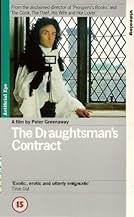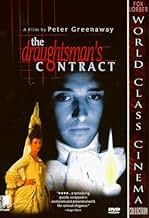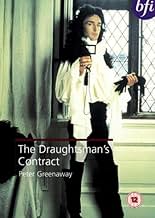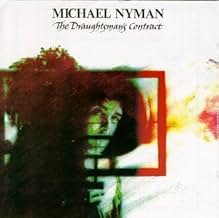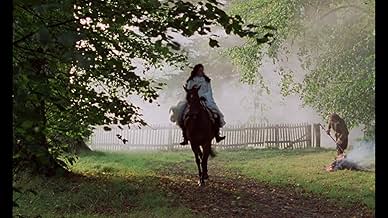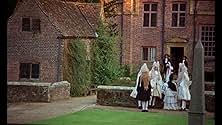IMDb RATING
7.2/10
12K
YOUR RATING
A young artist is commissioned by the wife of a wealthy landowner to make a series of drawings of the estate while her husband is away.A young artist is commissioned by the wife of a wealthy landowner to make a series of drawings of the estate while her husband is away.A young artist is commissioned by the wife of a wealthy landowner to make a series of drawings of the estate while her husband is away.
- Awards
- 1 win & 4 nominations total
Anne-Louise Lambert
- Mrs. Talmann
- (as Anne Louise Lambert)
Nicholas Amer
- Mr. Parkes
- (as Nicolas Amer)
Lynda La Plante
- Mrs. Clement
- (as Lynda Marchal)
Alastair G. Cumming
- Philip - Mr. Neville's assistant
- (as Alastair Cummings)
- Director
- Writer
- All cast & crew
- Production, box office & more at IMDbPro
Featured reviews
"I think my films are always quite self-reflexive and always question 'why am I doing this, is this the right way to do it, what is cinema for, does it have a purpose?"
I'm glad I could find that quote from the man responsible of that film that had me scratching my head for hours and whistling its infectiously catchy tune. Indeed, Peter Greenaway's "The Draughtsman's Contract", directed in 1982, is one of these films that defy analysis and can only be approached through sketches drawn on your own intuition's boards, I watched it three times in a row and I know now that a fourth time will do no good.
And so I figured "what the heck?"... maybe there are some movies that are deliberately unreachable because even the author would fail to be explicit without betraying his own vision. Though I know some would label that film as pretentious nonsense, Greenaway's quote is the perfect getaway: he doesn't aim at the viewers with his films, he doesn't even aim at himself, what he knows is that the film comes from his own inspiration and that's what matters, the rest belongs to cinema.
But I'm sure I would have joined the bandwagon of criticism if it wasn't for one thing the film gets right and that any viewer can agree with: its photogenic beauty. After all, this is a film set in 1695 and so the baroque style invites itself into the picture and we have these intimate shots embedded in stark contrasts like in Caravaggio's paintings, not to mention an orgy of costume designs and make-up combining the most grotesque extremes of the so-called civilized world.
Greenaway while delighting your eyes with such visual marvels also provides great landscape shots that for once, serve a purpose and aren't there to look pretty on the camera. And so we have the beauty and simplicity of geometry and the treacherous nature of the upper-class waltzing together under the triumphant music of Michael Nymar, inspired by Henry Purcell. To put it simply, this is a film that is beautiful to look at and listen to, but that shouldn't take away the bizarreness of the plot..
In fact, the opening prepares to it with many conversations about architecture, one about many streaks of reservoirs dug under an estate could foreshadow the web of intrigues, and it reminded me of the reputation of the Versailles Palace in France, which as beautiful as it was, couldn't cover the stink in the corridors, visitors satisfying their urgent needs in hidden corners. But I'm digressing, let's get back to the film.
The film centers on a landscaper Mr. Neville (Anthony Haggins) who's too arrogant not to be a real ace in his trade, and there are two aristocratic couples: Mr. And Mrs. Herbert (Dave Hill and Janet Suzman) and their daughter and son-in-law the Talmans (Anne-Louise Lambert and Hugh Fraser). Neville signs a contract with the mother (let's call her that way for the sake of clarity), he must produce twelve landscape drawings of her country house, gardens and outbuildings included. Then Nevill adds a clause that's so special I could only copy-paste it: to meet Mr. Neville in private and to comply with his requests concerning his pleasure with me."
O tempora, o mores... I guess. Anyway, the sequences showing the process of sketching are fantastic to watch and the music just brings that energy that seems to prepare you to something. And then there's the mystery with many needless details intruding in the drawings: empty boots, a ladder, anything that look too incongruous but whose presence seem to prepare for something. There is also an odd man disguised as a statue and who doesn't do anything but appear but he, too must be there for a purpose.
Meanwhile, interactions consist merely on the mother honoring her part of the contract (not that she takes pleasure out of it), and Neville making fun of her son-in-law. Needless to say that Neville makes many enemies during the journey and when they try to cancel the contract, he refuses and one thing leading to another, it's the daughter taking the mother's place (since she inherited from her mother the talent to get the wrong man).
There's a lot going on, inheritance problems, absence of children, everything building up to a murder that occurs at two thirds of the film. And when you think that Neville had the making of a suave villain, he becomes the victim of his own shenanigans and his cockiness ends up backfiring at him, making him learn the hart way that one can't be pompous too long and as they say in French, the man just farted higher than his own... bottom. And at that point I won't spoil the rest of the film.
What Greenaway tried to express in his exhilaration of art and through its parallel with the things of flesh, a quest for pleasure within the work or maybe how an artist is immediately an outcast in his world. There's also a strange combination between the rigorism of his work and they way he lets loose details interfere with it, as if by lowering his guard that little, he would cause his own demise.
Anyway, I learned to lower my guard a little too and not expect to get a film, I'm sure there is a riddle in the film that wouldn't be solved even after ten times of viewing but I guess this is the kind of movies that tells pretty much something about the artist as much as it does about the art, and when he doesn't tell, it shows.
One valid and simple criticism, maybe Greenaway got carried away with the lighting and the wigs that he made it difficult to figure who's who (even the mother and daughter looked like they could be sisters).
I'm glad I could find that quote from the man responsible of that film that had me scratching my head for hours and whistling its infectiously catchy tune. Indeed, Peter Greenaway's "The Draughtsman's Contract", directed in 1982, is one of these films that defy analysis and can only be approached through sketches drawn on your own intuition's boards, I watched it three times in a row and I know now that a fourth time will do no good.
And so I figured "what the heck?"... maybe there are some movies that are deliberately unreachable because even the author would fail to be explicit without betraying his own vision. Though I know some would label that film as pretentious nonsense, Greenaway's quote is the perfect getaway: he doesn't aim at the viewers with his films, he doesn't even aim at himself, what he knows is that the film comes from his own inspiration and that's what matters, the rest belongs to cinema.
But I'm sure I would have joined the bandwagon of criticism if it wasn't for one thing the film gets right and that any viewer can agree with: its photogenic beauty. After all, this is a film set in 1695 and so the baroque style invites itself into the picture and we have these intimate shots embedded in stark contrasts like in Caravaggio's paintings, not to mention an orgy of costume designs and make-up combining the most grotesque extremes of the so-called civilized world.
Greenaway while delighting your eyes with such visual marvels also provides great landscape shots that for once, serve a purpose and aren't there to look pretty on the camera. And so we have the beauty and simplicity of geometry and the treacherous nature of the upper-class waltzing together under the triumphant music of Michael Nymar, inspired by Henry Purcell. To put it simply, this is a film that is beautiful to look at and listen to, but that shouldn't take away the bizarreness of the plot..
In fact, the opening prepares to it with many conversations about architecture, one about many streaks of reservoirs dug under an estate could foreshadow the web of intrigues, and it reminded me of the reputation of the Versailles Palace in France, which as beautiful as it was, couldn't cover the stink in the corridors, visitors satisfying their urgent needs in hidden corners. But I'm digressing, let's get back to the film.
The film centers on a landscaper Mr. Neville (Anthony Haggins) who's too arrogant not to be a real ace in his trade, and there are two aristocratic couples: Mr. And Mrs. Herbert (Dave Hill and Janet Suzman) and their daughter and son-in-law the Talmans (Anne-Louise Lambert and Hugh Fraser). Neville signs a contract with the mother (let's call her that way for the sake of clarity), he must produce twelve landscape drawings of her country house, gardens and outbuildings included. Then Nevill adds a clause that's so special I could only copy-paste it: to meet Mr. Neville in private and to comply with his requests concerning his pleasure with me."
O tempora, o mores... I guess. Anyway, the sequences showing the process of sketching are fantastic to watch and the music just brings that energy that seems to prepare you to something. And then there's the mystery with many needless details intruding in the drawings: empty boots, a ladder, anything that look too incongruous but whose presence seem to prepare for something. There is also an odd man disguised as a statue and who doesn't do anything but appear but he, too must be there for a purpose.
Meanwhile, interactions consist merely on the mother honoring her part of the contract (not that she takes pleasure out of it), and Neville making fun of her son-in-law. Needless to say that Neville makes many enemies during the journey and when they try to cancel the contract, he refuses and one thing leading to another, it's the daughter taking the mother's place (since she inherited from her mother the talent to get the wrong man).
There's a lot going on, inheritance problems, absence of children, everything building up to a murder that occurs at two thirds of the film. And when you think that Neville had the making of a suave villain, he becomes the victim of his own shenanigans and his cockiness ends up backfiring at him, making him learn the hart way that one can't be pompous too long and as they say in French, the man just farted higher than his own... bottom. And at that point I won't spoil the rest of the film.
What Greenaway tried to express in his exhilaration of art and through its parallel with the things of flesh, a quest for pleasure within the work or maybe how an artist is immediately an outcast in his world. There's also a strange combination between the rigorism of his work and they way he lets loose details interfere with it, as if by lowering his guard that little, he would cause his own demise.
Anyway, I learned to lower my guard a little too and not expect to get a film, I'm sure there is a riddle in the film that wouldn't be solved even after ten times of viewing but I guess this is the kind of movies that tells pretty much something about the artist as much as it does about the art, and when he doesn't tell, it shows.
One valid and simple criticism, maybe Greenaway got carried away with the lighting and the wigs that he made it difficult to figure who's who (even the mother and daughter looked like they could be sisters).
Is Greenaway our most intelligent filmmaker? One of them at least. He is master of lush self-referential allegory. Here this is hung on a mystery masquerading as restoration comedy. Just maintaining the period and manner is quite a feat.
Self-reference. The film is about an artist who creates rich images that include incongruous elements. The arrogance of the artist is balanced by his blindness as to the meaning, the context of what the images reveal. Both the artist and the viewers are confused by the meaning and flummoxed by the events that the meaning triggers. Greenaway clearly means this to extend to himself, his film and the incompleteness of what we the viewers see. The drawings and the drawer's hands are in fact his.
Fantasy-allegory. This is a film richer in symbology than Drowning and Cook, but probably less so than the later `book' movies. Great attention has been spent on recondite supplementary images, including a central painting in the house being itself painted by the draftsman and filmmaker. I viewed it (the whole film) once just for details. The living statue is only the most obvious illogical element, and in fact draws attention away from other smaller visual diversions.
Mystery artifice. The whole environment is one of genteel artifice, hiding cruel mechanics of conspiracy. The cleverness of the construction is that Greenaway and us are full conspirators. No one, not us, him or the characters shown fully understand what is going on. The mystery form has always been a dialog between artist and consumer, a contest to see who can outwit whom. Very clever use of the mystery form here to include us in the artifice by not ever `playing fair.'
Restoration comedy. Past the visual allegory and the fantasy mystery and the self-reference is a restoration comedy which taken straight is hilarious. The statue is from this form.
My only criticisms are minor. This film contains a restrained story, and incidentally all sex takes place offscreen. Why be so conservative in these areas? Also, Lady Herbert required a more powerful actress I think.
Self-reference. The film is about an artist who creates rich images that include incongruous elements. The arrogance of the artist is balanced by his blindness as to the meaning, the context of what the images reveal. Both the artist and the viewers are confused by the meaning and flummoxed by the events that the meaning triggers. Greenaway clearly means this to extend to himself, his film and the incompleteness of what we the viewers see. The drawings and the drawer's hands are in fact his.
Fantasy-allegory. This is a film richer in symbology than Drowning and Cook, but probably less so than the later `book' movies. Great attention has been spent on recondite supplementary images, including a central painting in the house being itself painted by the draftsman and filmmaker. I viewed it (the whole film) once just for details. The living statue is only the most obvious illogical element, and in fact draws attention away from other smaller visual diversions.
Mystery artifice. The whole environment is one of genteel artifice, hiding cruel mechanics of conspiracy. The cleverness of the construction is that Greenaway and us are full conspirators. No one, not us, him or the characters shown fully understand what is going on. The mystery form has always been a dialog between artist and consumer, a contest to see who can outwit whom. Very clever use of the mystery form here to include us in the artifice by not ever `playing fair.'
Restoration comedy. Past the visual allegory and the fantasy mystery and the self-reference is a restoration comedy which taken straight is hilarious. The statue is from this form.
My only criticisms are minor. This film contains a restrained story, and incidentally all sex takes place offscreen. Why be so conservative in these areas? Also, Lady Herbert required a more powerful actress I think.
Mr. Neville is a young arrogant artist full of himself. He is contracted to make landscape estate drawings by Mrs. Virginia Herbert. She has a bitter relationship with her wealthy landowning husband who leaves on a trip. She submits to Neville sexually as part of the contract. There is also her daughter Mrs. Talmann and her husband Mr. Talmann. The couple is childless taking care of his nephew. Mrs. Herbert tries to revoke the contract but Neville refuses. Mrs. Talmann blackmails Neville into entering a similar contract pointing out items in his drawings which indicate "misadventure". When Mr. Herbert is found dead in the moat, Neville is horrified to discover that he's the leading suspect.
This is an unusual film. It's a Shakespearian sex romp with a murder mystery. The style has long takes and mid to long distance visuals. The movie lost me the first time around. It can meander and the story can be mercurial. It would help a lot if the murder is shown even if the perpetrators are not. The individual clues need accompanying flashbacks to show that part of the crime. This has a certain amount of beauty and weird originality but it's not easy for everyone.
This is an unusual film. It's a Shakespearian sex romp with a murder mystery. The style has long takes and mid to long distance visuals. The movie lost me the first time around. It can meander and the story can be mercurial. It would help a lot if the murder is shown even if the perpetrators are not. The individual clues need accompanying flashbacks to show that part of the crime. This has a certain amount of beauty and weird originality but it's not easy for everyone.
Hugely enjoyable, if somewhat a tad too clever for its own good. A very good English director's attempt to be more continental, by being deliberately obscure, and throwing in large dollops of raunchy eroticism. Imagine if you will an episode of PBS's Mystery set during the Restoration, with a script by Einstein, and direction by Frederico Fellini.
Two excellent stage actors - Anthony Higgins and Janet Suzman - in combination with the very sultry and seldom seen Australian actress Anne Louise Lambert, act their sexy sox off in this delightful delicate pastry of a movie. In the year 1694 an artist is commissioned to create a series of precise drawings of an enormous country house. The twist is that his agreed form of payment is most unusual.
Michael Nyman's score is a careful, yet loud, modern arrangement with contemporary wind and string instruments. The photography by Curtis Clark is incredible, and these two creative artists convince you, you are in the 17th Century. The interior scenes are lit only by candlelight - as was also the case in Kubrick's superb historical masterpiece Barry Lyndon. This movie somehow combines elements of sophisticated themes of woman's self-empowerment, the inhumanity of the aristocracy, mathematics, and Benny Hill eroticism. Really rather wonderful and unique, but also in-retrospect, less than the sum of its parts. For a superior Peter Greenaway picture, try Drowning By Numbers, A Zed and Two Naughts, and The Cook, the Wife, etc..
Two excellent stage actors - Anthony Higgins and Janet Suzman - in combination with the very sultry and seldom seen Australian actress Anne Louise Lambert, act their sexy sox off in this delightful delicate pastry of a movie. In the year 1694 an artist is commissioned to create a series of precise drawings of an enormous country house. The twist is that his agreed form of payment is most unusual.
Michael Nyman's score is a careful, yet loud, modern arrangement with contemporary wind and string instruments. The photography by Curtis Clark is incredible, and these two creative artists convince you, you are in the 17th Century. The interior scenes are lit only by candlelight - as was also the case in Kubrick's superb historical masterpiece Barry Lyndon. This movie somehow combines elements of sophisticated themes of woman's self-empowerment, the inhumanity of the aristocracy, mathematics, and Benny Hill eroticism. Really rather wonderful and unique, but also in-retrospect, less than the sum of its parts. For a superior Peter Greenaway picture, try Drowning By Numbers, A Zed and Two Naughts, and The Cook, the Wife, etc..
This is a most intricately structured enigma of a film, one that seems on the surface to be ordinary, but underneath has many layers that need examining in detail from several viewings. The story is set in the English countryside in 1694. The prominent character is a draughtsman named Mr. Neville, who is asked by a lady named Mrs. Herbert to make twelve drawings of her house from different angles. He agrees, as long as he can have the lady for his intimate pleasure.
Mr. Neville is a perfectionist, and very meticulous in his drawings. He states to everyone at the house all his rules about everything that has to remain in the same place while he draws. The film moves along nicely, everything seems usual, then events start to become strange. Stone statues start to move around, and take up different locations to contort into another static pose. Objects start to change location to confuse Mr. Neville in his drawings. Then Mrs. Herbert's daughter approaches Mr. Neville and tells him her father may have been murdered. She says she has evidence to indict Mr. Neville of his murder, and blackmails him, requesting his service for her sexual needs. Then Mr. Herbert's body is found in a ditch and things get even more complex.
This film is one of those that you need to watch and try and unravel yourself. To try to do that here in this review is almost impossible. I recommend it. It is exquisitely performed and filmed. The costumes are good. The speeches by the cast are delivered in a grandiose and statement-like manner. The music is appropriate. A classic piece of puzzling cinema that will have you watching it many times.
Mr. Neville is a perfectionist, and very meticulous in his drawings. He states to everyone at the house all his rules about everything that has to remain in the same place while he draws. The film moves along nicely, everything seems usual, then events start to become strange. Stone statues start to move around, and take up different locations to contort into another static pose. Objects start to change location to confuse Mr. Neville in his drawings. Then Mrs. Herbert's daughter approaches Mr. Neville and tells him her father may have been murdered. She says she has evidence to indict Mr. Neville of his murder, and blackmails him, requesting his service for her sexual needs. Then Mr. Herbert's body is found in a ditch and things get even more complex.
This film is one of those that you need to watch and try and unravel yourself. To try to do that here in this review is almost impossible. I recommend it. It is exquisitely performed and filmed. The costumes are good. The speeches by the cast are delivered in a grandiose and statement-like manner. The music is appropriate. A classic piece of puzzling cinema that will have you watching it many times.
Did you know
- TriviaDirector Peter Greenaway, a former art student, created the sketches that feature in the film. In fact the close-up shots of the draughtsman drawing are of his hands.
- GoofsThe cooing of a collared dove is not a sound that would have fallen on Jacobean ears, as the species was unknown in Britain until 1955.
- Quotes
Mr. Neville: You must forgive my curiosity, madam, and open your knees.
- Alternate versionsWhen Peter Greenaway screened the movie at festivals in 1982, it ran a full three hours. Included in this footage is a full and further explained rationale for the moving statue.
- How long is The Draughtsman's Contract?Powered by Alexa
Details
- Release date
- Country of origin
- Languages
- Also known as
- The Draughtsman's Contract
- Filming locations
- Groombridge Place, Groombridge, Kent, England, UK(country house)
- Production companies
- See more company credits at IMDbPro
Box office
- Budget
- £320,000 (estimated)
- Gross US & Canada
- $2,256,246
- Gross worldwide
- $2,283,233
Contribute to this page
Suggest an edit or add missing content




